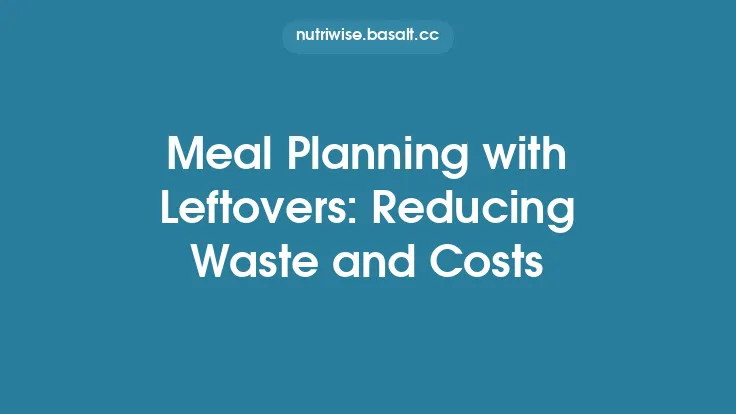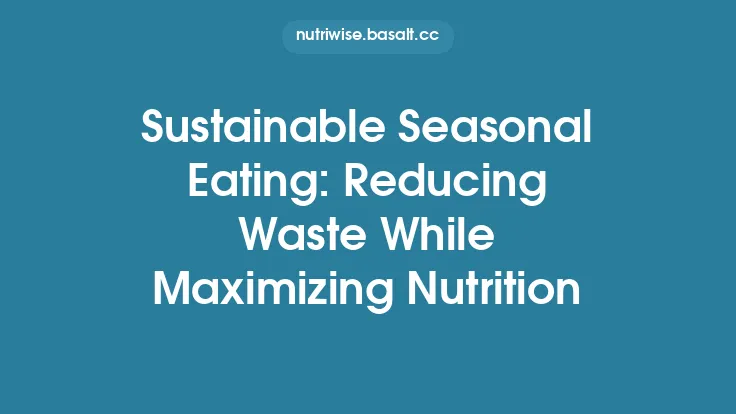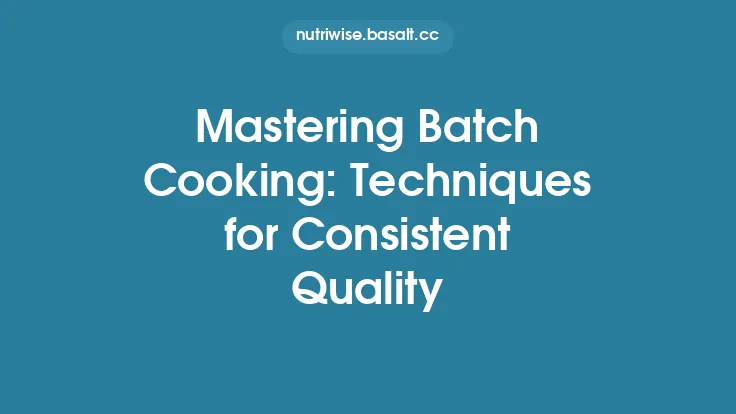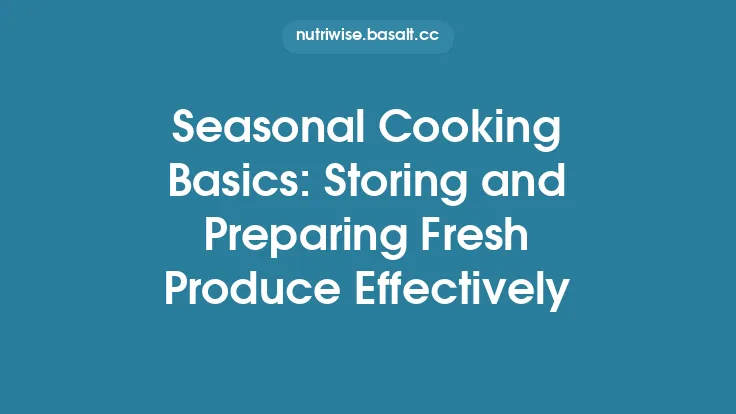Batch cooking and freezing have become powerful allies for anyone looking to shrink their food‑waste footprint while reclaiming precious time in a busy schedule. By preparing large quantities of meals in a single session and preserving them at sub‑zero temperatures, you can dramatically reduce the amount of edible food that would otherwise be discarded, avoid the frantic “what’s for dinner?” scramble, and keep your kitchen running like a well‑oiled machine. Below is a comprehensive guide that walks you through the why, the how, and the what‑next of batch cooking and freezing, with a focus on sustainability, nutrition, and practical execution.
Why Batch Cooking Works for Waste Reduction
1. Minimizes Over‑Preparation and Spoilage
When you cook in bulk, you control the exact amount of each ingredient you purchase and use. This eliminates the common scenario of buying a bag of carrots for a single stir‑fry, only to find the remainder wilting after a few days. By converting perishable items into frozen meals, you extend their usable life from days to months.
2. Reduces Energy Use per Portion
Cooking a single pot of soup for a family of four uses roughly the same amount of gas or electricity as cooking four individual servings. The energy cost per serving drops dramatically, and the subsequent reheating of frozen portions consumes far less energy than cooking from scratch each night.
3. Lowers Packaging Waste
Bulk purchasing of staple ingredients (e.g., grains, legumes, frozen meat packs) often comes in larger, more recyclable containers. When you freeze meals in reusable containers or freezer‑safe bags, you avoid the need for single‑use packaging that would accompany multiple small‑scale meals.
4. Encourages Thoughtful Ingredient Selection
Batch cooking forces you to think ahead about the nutritional balance of each meal, prompting the inclusion of a variety of vegetables, proteins, and whole grains. This intentionality reduces the temptation to rely on convenience foods that often come in wasteful packaging.
Planning Your Batch Cooking Sessions
Effective batch cooking starts with a structured plan that aligns with your household’s rhythm and dietary preferences.
A. Calendar Mapping
Identify a consistent day (often a weekend) to dedicate 2–4 hours to cooking. Mark the number of meals you intend to produce and the days you’ll consume them. This visual schedule prevents accidental over‑production.
B. Ingredient Inventory Audit
Before you shop, take stock of what you already have in the pantry, fridge, and freezer. Prioritize using items that are nearing the end of their shelf life. This “first‑in, first‑out” approach ensures you’re not buying duplicates of what you already own.
C. Recipe Cohesion
Select recipes that share base ingredients (e.g., a large batch of roasted vegetables can be divided among a curry, a grain bowl, and a soup). This reduces the number of distinct items you need to purchase and simplifies the cooking process.
D. Portion Strategy
Decide whether you’ll freeze individual servings, family‑size portions, or a hybrid. Individual servings are ideal for single‑person households and reduce the risk of thawing more than needed, while family‑size portions can be more efficient for larger families.
Choosing Recipes Suited for Freezing
Not every dish survives the freeze‑thaw cycle equally. Here’s a quick guide to the categories that retain texture, flavor, and nutritional value:
| Best‑Freezing Candidates | Why They Freeze Well | Examples |
|---|---|---|
| Stews & Braises | Long cooking breaks down connective tissue, creating a cohesive sauce that re‑emulsifies on reheating. | Beef bourguignon, lentil stew |
| Casseroles | Structured layers hold together; cheese and breadcrumbs develop a pleasant crust after reheating. | Veggie lasagna, quinoa‑black bean bake |
| Soups (excluding cream‑based) | Broths freeze without separation; vegetables stay intact if cut uniformly. | Tomato basil soup, minestrone |
| Grains & Legumes (pre‑cooked) | Fully cooked grains retain shape; legumes become tender, reducing cooking time later. | Brown rice, chickpeas |
| Marinated Proteins | Freezing in the marinade doubles as a tenderizing step; flavor penetrates deeply. | Chicken thighs in teriyaki, tofu in curry sauce |
| Sauces & Pestos | High‑fat sauces (tomato‑based, herb‑oil) freeze without texture loss; just stir after thawing. | Marinara, chimichurri |
Avoid or Modify: Dishes with high water content vegetables (e.g., lettuce, cucumbers) that become mushy, and delicate herbs that lose aroma. For these, consider adding fresh herbs after reheating.
Essential Equipment and Tools
Investing in a few key items can streamline the batch‑cooking workflow and improve the quality of frozen meals.
- Heavy‑Duty Stockpot & Dutch Oven – Ideal for large‑volume soups, stews, and braises.
- Sheet Pan with Rim – Perfect for roasting vegetables in a single layer, ensuring even caramelization.
- Food Processor – Quickly chops, purees, or grates large batches of produce.
- Immersion Blender – Smooths soups directly in the pot, reducing transfer steps.
- Freezer‑Safe Containers – Choose BPA‑free plastic containers with tight‑locking lids, or glass jars rated for freezer use (leave headspace).
- Freezer Bags (Vacuum‑Seal or Zip‑Lock) – For flat‑lay freezing, which saves space and speeds thawing.
- Label Maker or Waterproof Markers – Consistent labeling prevents “mystery meals” and helps track shelf life.
- Digital Scale – Enables precise portioning, especially for protein‑rich dishes where portion control matters for nutrition.
- Blast Freezer (Optional) – If you have the budget, a small countertop blast freezer reduces the time food spends in the “danger zone” (4 °C–60 °C), preserving texture and nutrients.
Preparing Ingredients for Optimal Freeze Quality
A. Blanching Vegetables
Blanching (briefly boiling, then shocking in ice water) deactivates enzymes that cause color loss and off‑flavors. For example, blanch broccoli for 2–3 minutes before freezing to retain its bright green hue.
B. Pre‑Seasoning vs. Post‑Seasoning
Season dishes before freezing when the flavors benefit from a meld (e.g., stews). For delicate herbs or spices that may become muted, add them after reheating.
C. Moisture Management
Pat dry excess water from cooked proteins and vegetables before packing. Excess moisture leads to ice crystals, which can cause freezer burn and degrade texture.
D. Portioning Technique
Use a kitchen scale to allocate consistent gram or ounce portions. This not only aids in nutritional tracking but also ensures uniform thawing times.
Freezing Techniques: Blanching, Flash Freezing, and Portioning
- Flash Freezing Individual Items
- Spread pieces (e.g., diced fruit, cooked meat cubes) on a parchment‑lined tray.
- Freeze uncovered for 1–2 hours until solid.
- Transfer to freezer bags, removing as much air as possible. This prevents clumping and makes it easy to grab a handful later.
- Layered Freezing for Soups and Sauces
- Allow the hot liquid to cool to room temperature.
- Portion into containers, leaving 1 cm headspace for expansion.
- Seal and label. For soups with noodles, consider adding the noodles fresh during reheating to avoid sogginess.
- Vacuum Sealing
- Removes oxygen, dramatically extending shelf life (up to 2–3 years for some items) and reducing freezer burn.
- Ideal for bulk proteins, pre‑cooked grains, and sauces.
- Freezer‑Bag “Flat‑Lay” Method
- Lay the bag flat on a tray while the contents are still liquid.
- Once frozen, stack the bags. This creates thin, uniform slabs that thaw quickly in the microwave or refrigerator.
Labeling and Inventory Management
A systematic labeling system is the backbone of a waste‑free freezer.
- Date of Production – Use the ISO format (YYYY‑MM‑DD) for easy sorting.
- Meal Name & Main Ingredients – Helps you locate meals that match your current cravings or dietary needs.
- Portion Size – Indicate weight (e.g., “250 g”) or serving count.
- Best‑Before Date – While frozen foods can remain safe for long periods, quality declines after 3–6 months for most dishes. Mark a “use by” date to prioritize older items.
- Nutritional Snapshot (Optional) – For those tracking macros, a quick note of calories, protein, carbs, and fat per portion can be valuable.
Maintain a simple spreadsheet or freezer inventory app where you log each entry. Periodically review the list to plan meals around items approaching their “best‑before” date, ensuring nothing languishes unnoticed.
Thawing and Reheating: Maintaining Safety and Quality
Safe Thawing Methods
| Method | Time Required | Best For | Notes |
|---|---|---|---|
| Refrigerator (overnight) | 8–12 hrs per 500 g | All meals | Keeps food in the safe temperature zone (≤4 °C). |
| Cold Water Bath (sealed bag) | 1–2 hrs per 500 g | Smaller portions | Change water every 30 min. |
| Microwave (defrost setting) | 5–10 min | Quick meals | Use immediately after thawing to avoid partial cooking. |
| Direct Cooking from Frozen | Variable | Soups, stews, casseroles | Skip thawing; increase cooking time by ~50 %. |
Reheating Tips
- Stir Frequently – For soups and sauces, stirring prevents hot spots and ensures even heating.
- Add Moisture – A splash of broth, water, or milk can revive dishes that have dried out during freezing.
- Finish with Fresh Elements – Add a handful of fresh herbs, a squeeze of lemon, or a drizzle of oil just before serving to brighten flavors.
Nutritional Impacts of Freezing
Freezing is a gentle preservation method that retains most macro‑ and micronutrients. However, a few nuances are worth noting:
- Vitamin Retention – Water‑soluble vitamins (C, B‑complex) can experience a modest loss (5‑15 %) during blanching and the freeze‑thaw cycle. Mitigate this by using minimal blanching time and rapid cooling.
- Protein Quality – Freezing does not denature proteins; in fact, it can make some proteins more digestible by breaking down cell walls.
- Fat Oxidation – Exposure to air can cause oxidation of unsaturated fats, leading to off‑flavors. Vacuum sealing or using airtight containers minimizes this risk.
- Fiber – Remains stable; frozen vegetables retain their fiber content, making them an excellent source for long‑term storage.
Overall, the nutritional profile of a well‑prepared frozen meal is comparable to its freshly cooked counterpart, especially when you incorporate a variety of vegetables and lean proteins.
Cost and Environmental Calculations
Financial Savings
- Bulk Purchasing – Buying grains, beans, and meat in larger quantities can reduce unit cost by 20‑40 %.
- Reduced Food Waste – The USDA estimates that the average American household wastes about $1,500 worth of food annually. By converting perishable items into frozen meals, you can cut this waste by up to 50 %, translating to $750 saved per year.
- Energy Efficiency – Cooking a single large pot uses roughly the same energy as multiple small pots. If you cook 4 meals at once, you save about 30 % of the energy that would be spent cooking each meal separately.
Environmental Impact
- Lower Greenhouse Gas Emissions – Less food waste means fewer methane emissions from landfills. A typical household that reduces waste by 30 kg per year avoids roughly 0.5 tonnes of CO₂‑equivalent emissions.
- Reduced Packaging – Bulk buying and reusing freezer containers cut down on single‑use plastic and cardboard waste.
- Energy Use – Freezers consume electricity, but modern ENERGY STAR‑rated models use about 300 kWh per year. When balanced against the emissions saved from avoided waste and reduced cooking cycles, the net environmental benefit is positive.
Scaling Up: Batch Cooking for Families and Communities
Family‑Size Strategies
- Theme Nights – Designate a weekly “theme” (e.g., Mexican, Mediterranean) and batch‑cook a base (rice, beans, seasoned protein) that can be recombined in different ways throughout the week.
- Kid‑Friendly Portions – Freeze mini‑meals in silicone muffin trays. These bite‑size portions are perfect for school lunches and reduce the temptation to over‑serve.
Community Initiatives
- Co‑op Freezer Shares – Neighborhood groups can pool resources to purchase bulk ingredients and share frozen meals, reducing individual costs and waste.
- Food‑Bank Partnerships – Surplus frozen meals can be donated to local food banks, extending the impact of your batch‑cooking efforts beyond your household.
Common Pitfalls and How to Avoid Them
| Pitfall | Consequence | Solution |
|---|---|---|
| Over‑crowding the freezer | Poor air circulation → uneven freezing & freezer burn | Store items with space between them for the first few hours; use flat‑lay bags |
| Forgetting to label | “Mystery meals” → accidental waste | Adopt a labeling habit immediately after each pack; keep a master inventory list |
| Using low‑quality containers | Cracking, leaks, and chemical leaching | Invest in BPA‑free, freezer‑rated containers; replace worn items promptly |
| Thawing at room temperature | Bacterial growth risk | Stick to refrigerator, cold water, or microwave methods |
| Freezing high‑water vegetables whole | Texture loss, mushiness | Blanch or pre‑roast vegetables before freezing; consider using them in soups where texture is less critical |
| Ignoring portion sizes | Over‑cooking or waste when reheating | Use a scale to portion; freeze in single‑serve containers for easy reheating |
Integrating Batch Cooking with Broader Sustainability Practices
While batch cooking and freezing are powerful on their own, they become even more effective when paired with complementary sustainable habits:
- Seasonal Shopping – Base your bulk purchases on what’s in season, reducing the carbon footprint associated with out‑of‑season produce.
- Zero‑Waste Kitchen Tools – Use reusable silicone bags and glass containers to eliminate disposable freezer bags.
- Energy‑Smart Freezer Placement – Keep the freezer in a cool, well‑ventilated area away from heat sources to improve efficiency.
- Renewable Energy – If possible, power your kitchen appliances with renewable electricity (solar, wind) to further lower the carbon impact of cooking and freezing.
Future Trends: Technology and Innovation in Home Freezing
The home food‑preservation landscape is evolving rapidly:
- Smart Freezers – Wi‑Fi‑enabled units that monitor temperature, send alerts when doors are left open, and track inventory via barcode scanning.
- Rapid‑Freeze Drawers – Compact appliances that achieve blast‑freezing speeds without the footprint of a full‑size commercial unit.
- Edible Coatings – Emerging food‑grade sprays that reduce ice crystal formation, preserving texture and flavor.
- AI‑Driven Meal Planning Apps – Algorithms that suggest batch‑cooking schedules based on pantry inventory, dietary goals, and expiration dates, minimizing waste automatically.
Staying informed about these innovations can help you refine your batch‑cooking system and keep it aligned with the latest sustainability standards.
In Summary
Batch cooking and freezing transform the kitchen from a place of daily scramble into a strategic hub for waste reduction, time savings, and nutritional consistency. By thoughtfully selecting recipes, mastering preparation and freezing techniques, and maintaining a disciplined labeling and inventory system, you can enjoy a diverse menu of home‑cooked meals while dramatically cutting food waste and its associated environmental costs. Whether you’re feeding a single professional, a bustling family, or a community co‑op, the principles outlined here provide a solid, evergreen foundation for a more sustainable, efficient, and enjoyable culinary routine.





